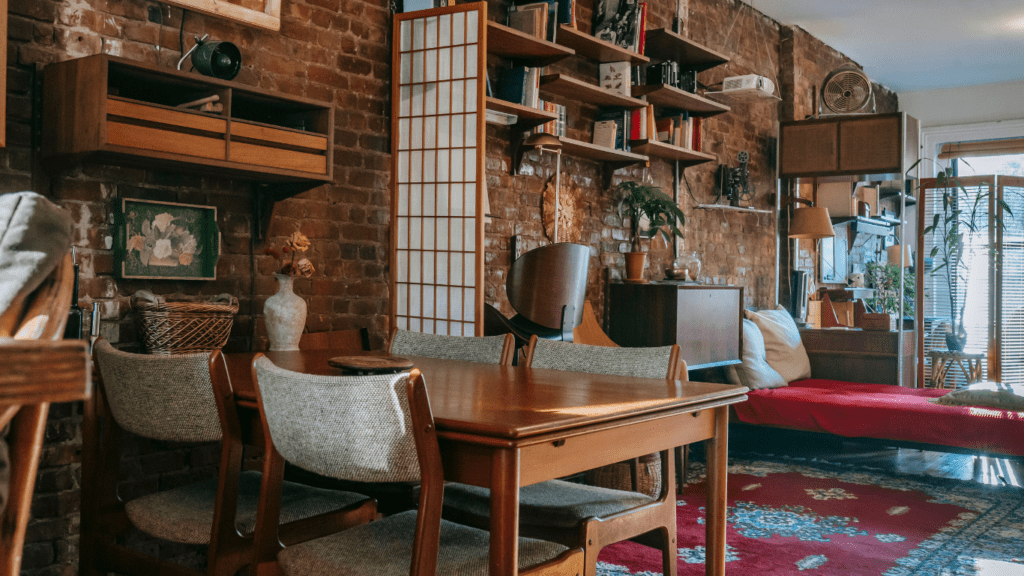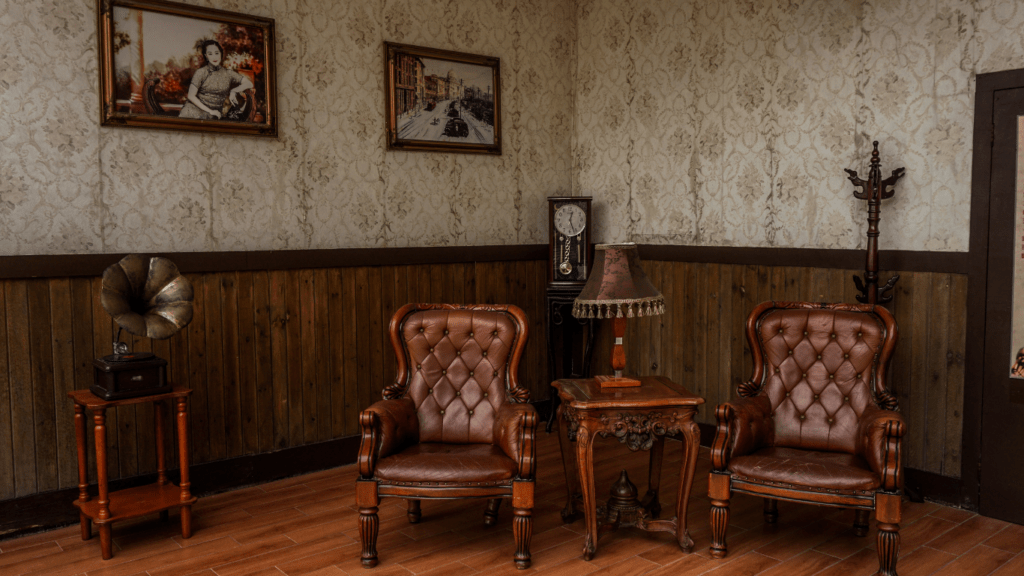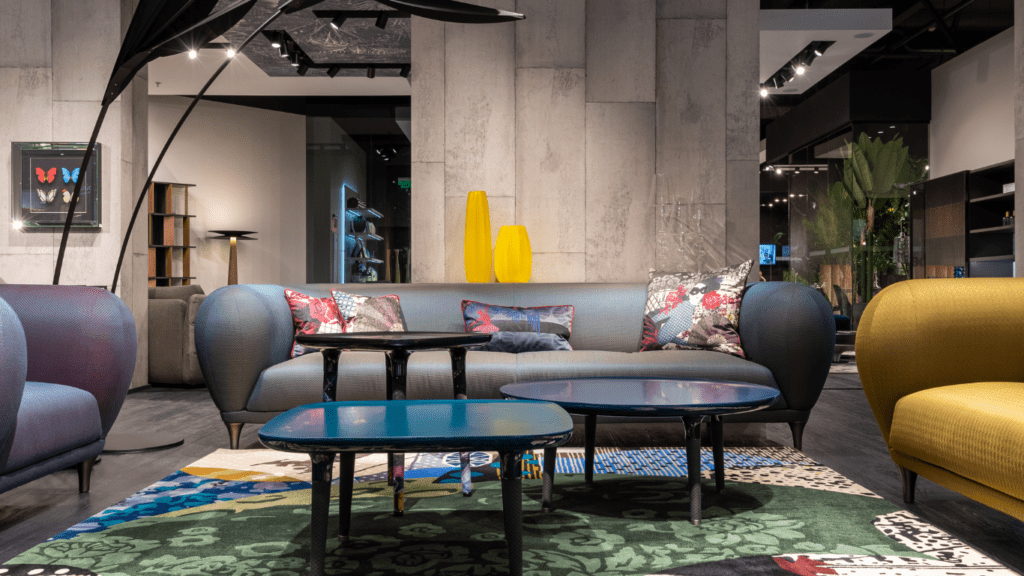Overview Of Vintage Interior Design Trends
Examining vintage interior design encompasses a broad range of styles from different eras, each bringing unique charm to any space. Key trends include Mid-century Modern, Art Deco, and Victorian.
Mid-Century Modern
Mid-century modern design focuses on simplicity and functionality. Originating in the 1940s-1960s, this style features clean lines, organic forms, and minimal ornamentation. Furniture often uses natural materials like wood and leather. For example, a sleek teak coffee table or a leather lounge chair can serve as focal points.
Art Deco
Art Deco emerged in the 1920s and 1930s, characterized by rich colors, bold geometric shapes, and luxurious materials. Intricate details often adorn furnishings and decor. Examples include a mirrored dresser or a geometric-patterned rug. These elements add a touch of opulence to any room.
Victorian
Victorian design, originating from the mid-to-late 19th century, emphasizes elegance and ornate details. It features dark woods, rich fabrics, and intricate patterns. Furnishings like tufted sofas and carved wooden cabinets convey historical sophistication. This style often incorporates accessories such as brass chandeliers and elaborate rugs.
Blending Eras
Blending vintage pieces from different eras creates a unique and personalized space. One can mix a Mid-century modern coffee table with an Art Deco lamp and a Victorian armchair. This approach adds depth and character to interiors, making them visually engaging.
Sustainable and Eco-friendly Choices
Choosing vintage items often supports sustainability. Reusing and repurposing old furniture reduces waste and promotes eco-friendly living. For instance, restoring an old wooden dining table instead of purchasing a new one can be both stylish and sustainable.
Accessibility and Affordability
Vintage items vary widely in price, offering options for different budgets. Thrift stores, antique shops, and online marketplaces like eBay and Etsy provide affordable vintage finds. High-end vintage stores and auction houses offer rare pieces for discerning collectors.
Popular Colors and Patterns
Vintage design often features bold, vibrant colors and distinctive patterns. Mid-century modern favors earth tones and geometric patterns. Art Deco uses metallics and vivid hues. Victorian design leans towards deep, rich colors and floral patterns. Integrating these colors and patterns can enhance a vintage-themed room.
Conclusion
Vintage interior design trends offer timeless appeal and versatility. Whether drawn to the clean lines of Mid-century modern or the opulence of Art Deco, these styles can create inviting and unique spaces that reflect personal taste.
Key Elements Of Nostalgic Design

Vintage interior design trends center on incorporating timeless pieces that evoke a sense of history. Specific furniture styles, color schemes, and decorative accents define the nostalgic look.
Furniture Styles
Furniture styles play a crucial role in achieving a nostalgic design. Mid-century modern furniture emphasizes clean lines, tapered legs, and functionality. Pieces like Eames chairs and teak wood tables are quintessential examples. Victorian furniture, on the other hand, focuses on ornate details, curved lines, and rich upholstery. Think tufted sofas, carved wood armchairs, and velvet fabrics. Art Deco introduces a touch of glam with its sleek, geometric shapes and luxurious materials like glass and chrome.
Color Schemes
Color schemes set the mood in nostalgic design. Mid-century modern favors earthy tones like olive green, mustard yellow, and burnt orange, paired with neutral bases. Art Deco leans towards bold, contrasting colors like black, gold, and deep blue, often accented with metallic finishes. Victorian palettes feature deep, rich colors such as burgundy, emerald green, and navy blue, complemented by floral patterns and intricate wallpapers.
Decorative Accents
Decorative accents bring the vintage theme together. Mid-century modern design uses minimalist decor, such as abstract art and geometric rugs. Art Deco incorporates statement pieces like:
- ornate mirrors
- crystal chandeliers
- bold sculptures
Victorian design emphasizes elaborate decor, including heavy drapes, detailed vases, and lace curtains. Incorporating these accents creates a nostalgic ambiance that reflects the charm and character of past eras.
Popular Vintage Eras
Vintage interior design encompasses various distinctive styles from different periods. Each era offers unique elements that contribute to the nostalgic charm of a space.
Mid-Century Modern
Mid-century modern design emerged in the mid-20th century, emphasizing simplicity and functionality. It features clean lines, organic forms, and minimal ornamentation. Iconic pieces like the Eames Lounge Chair and Noguchi Coffee Table highlight this era’s aesthetic. The color palette favors earthy tones, including mustard, olive green, and burnt orange, coupled with materials like wood, metal, and glass to create balanced, harmonious spaces.
Art Deco
Art Deco, popular from the 1920s to the 1940s, epitomizes luxury and glamour. It incorporates bold geometric shapes, rich colors, and lavish materials like marble and lacquer. Key pieces include mirrored furniture, sunburst motifs, and vibrant textiles. This style often uses high-contrast color schemes, such as black and gold or deep blue and silver, to make a striking visual statement. Decorative accents like crystal chandeliers and sculptural vases add opulence to interiors.
Victorian
The Victorian era, spanning from 1837 to 1901, is known for its elegance and detail. Ornate furniture with intricate carvings, heavy drapery, and rich upholstery typify this period. Popular pieces include tufted sofas, claw-foot tables, and four-poster beds. The color scheme features deep, rich hues like burgundy, navy, and forest green, often paired with intricate floral patterns and wallpapers. Embellishments such as lace curtains, brass candelabras, and porcelain figurines enhance the sophisticated ambiance.
How To Incorporate Vintage Trends In Modern Homes
Combining vintage elements with modern design creates a unique, personalized space. Balancing old and new requires thoughtful selection and integration of pieces.
Choosing The Right Pieces
Identifying the right vintage pieces ensures a cohesive look. Start with iconic furniture like Eames chairs or Victorian settees, which add immediate character. Select items that reflect personal style and complement existing decor. Use vintage lighting fixtures such as chandeliers or mid-century lamps to create focal points. Incorporate smaller items like ornate mirrors or retro clocks for subtle touches.
Blending With Contemporary Styles
Integrating vintage items with contemporary styles creates a harmonious environment. Pair mid-century modern furniture with sleek, minimalist decor to maintain clean lines and functionality. Combine Art Deco elements such as bold geometric patterns and luxurious materials with modern, neutral backdrops to soften and balance the overall look. Mix Victorian pieces like intricate brass items or rich upholstery with simple, understated contemporary furnishings to avoid overwhelming the space. Use color schemes to tie it all together, like pairing earthy mid-century tones with vibrant Art Deco contrasts or deep Victorian hues.
Benefits Of Vintage Interior Design
Vintage interior design offers numerous benefits that enhance both aesthetics and functionality. Here’s a look at two significant advantages of incorporating vintage elements into your home decor:
Sustainability
Using vintage pieces contributes to environmental sustainability. These items reduce the need for new production and decrease waste. Vintage furniture often comes from high-quality materials, ensuring longevity and fewer replacements. For instance, hardwood furniture from the mid-century era stands the test of time due to its craftsmanship. Reusing vintage decor minimizes your carbon footprint.
Unique Character
Vintage items bring unique character to any space. Each piece often carries a history, adding depth and personality to rooms. For example, an Art Deco lamp can serve as a focal point, sparking conversations. No mass-produced item can replicate the charm of a handcrafted Victorian settee. Incorporate vintage elements to create a distinctive, individualized home.



 Smart Home Technology Consultant
Meagan Kanedooray serves as Luxe House Maker’s smart home technology consultant, with extensive experience in integrating advanced tech into luxury homes. Specializing in home automation, security systems, and energy-efficient solutions, Meagan helps readers transform their living spaces into seamless, tech-enabled environments. Her expertise in cutting-edge technologies ensures that Luxe House Maker’s audience stays informed about the latest innovations that enhance convenience, safety, and sustainability in luxury living. Meagan’s deep understanding of smart home trends makes her an invaluable resource for those looking to elevate their homes with the latest advancements in technology.
Smart Home Technology Consultant
Meagan Kanedooray serves as Luxe House Maker’s smart home technology consultant, with extensive experience in integrating advanced tech into luxury homes. Specializing in home automation, security systems, and energy-efficient solutions, Meagan helps readers transform their living spaces into seamless, tech-enabled environments. Her expertise in cutting-edge technologies ensures that Luxe House Maker’s audience stays informed about the latest innovations that enhance convenience, safety, and sustainability in luxury living. Meagan’s deep understanding of smart home trends makes her an invaluable resource for those looking to elevate their homes with the latest advancements in technology.
